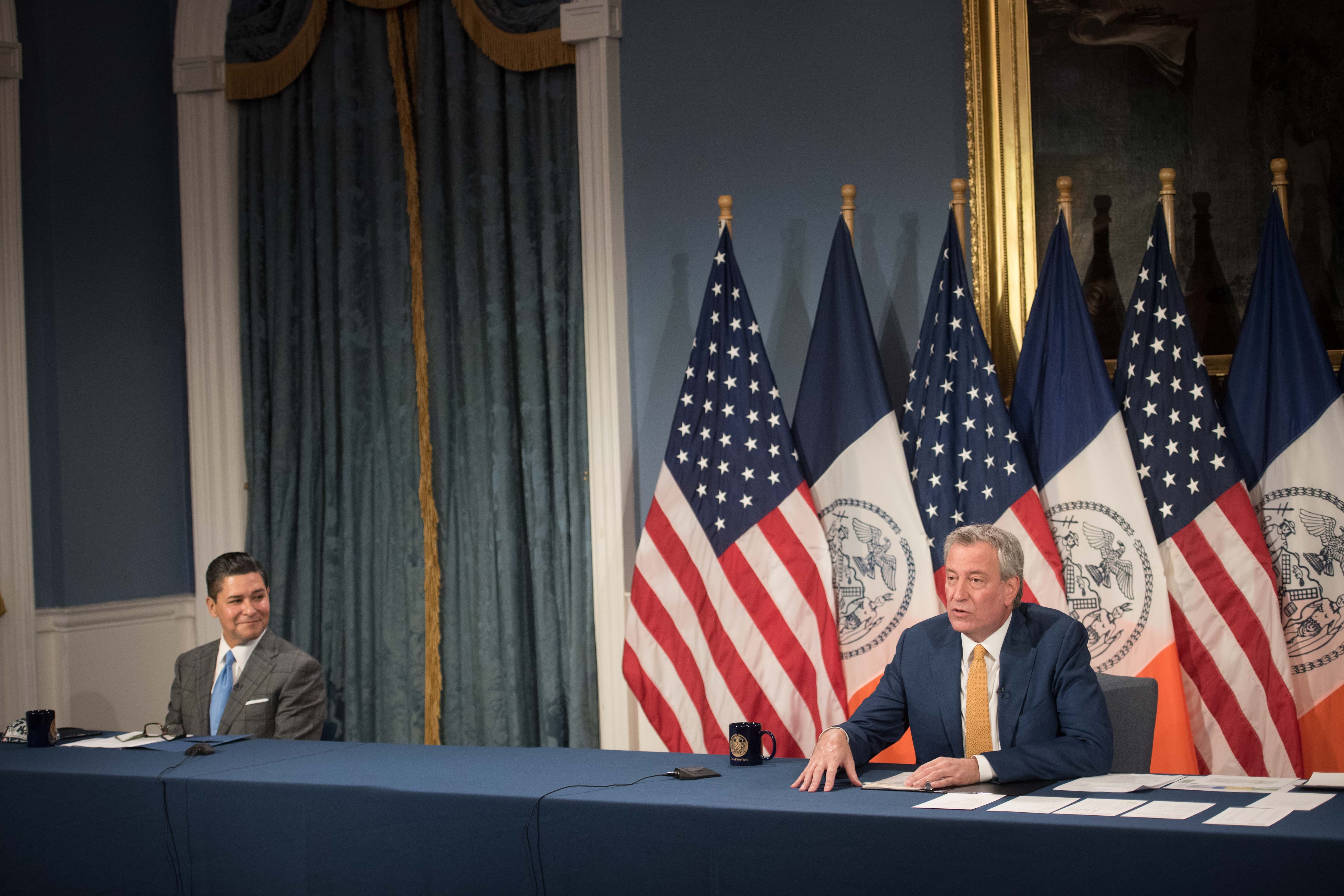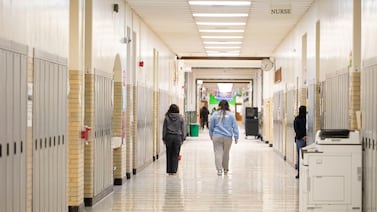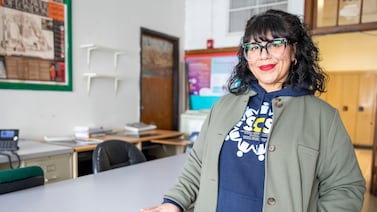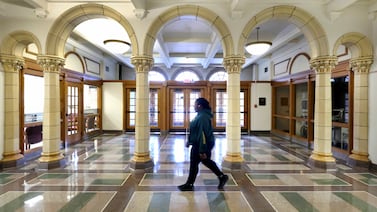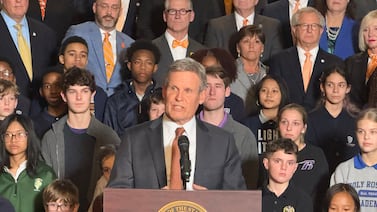New York City students will only attend school one to three days a week next school year, with the exact number rotating weekly based on student enrollment and building capacity, officials said Wednesday.
School leaders will choose among staggered schedules to accommodate dramatically fewer children and staff in buildings, while students learn remotely for the remainder of the school week as the coronavirus still circulates in the city.
For some overcrowded schools that only have room to serve about a third of their normal enrollment at a given time, students might attend school every two days — though every few weeks, they would only be in class for one day. (Some schools can accommodate even fewer than 30% percent of students at a time.)
Some students with disabilities will be offered a full week of in-person instruction, when building space allows. Schools in District 75, which serve students with more complex disabilities, will have their own scheduling options to choose from.
The education department is also allowing families to opt for full-time remote learning, which could help schools that are grappling with how they will staff their in-person classes. If the city’s roll-out of fully remote summer school this week is any indication, offering students a totally online version of classes next year won’t be easy for the department to pull off: Many educators and students have not been provided with full access to summer coursework days after summer school was scheduled to start.
Families can begin to register for fully remote instruction on July 15, and the deadline to do so is August 7. Students can switch to remote-only learning at any point throughout the school year and can choose to return for in-person instruction on a quarterly basis, the chancellor said.
The education department is planning a series of information sessions, which will kick off on July 16. Principals are expected to inform families of their individual school’s plan sometime in August.
“For the vast majority of kids,” Mayor Bill de Blasio said at a press conference, “you’ll either be going two days a week or three days a week, depending on the week.”
He added: “This is new and different, and I know it’s no one’s first choice.”
The city’s announcement was light on key details, and officials still must submit a plan for state approval. State leaders could ultimately decide not to allow schools to reopen in the fall.
In New York City, officials did not say to what extent live online instruction will be required, though Schools Chancellor Richard Carranza said there will be some requirement to hold live lessons. (Live instruction was not required when school buildings shut down but is mandatory for summer school.)
There was no mention of what procedures will be in place if a member of a school community tests positive for the coronavirus — a major source of frustration before schools shut down in March and the subject of an investigation.
Reopening the country’s largest school system is a crucial piece of reopening the economy and allowing parents to get back to work. But the part-time schedule still presents an enormous child care challenge for many families, including teachers, principals, and other school staff with children. Officials did not provide details on how they expect families with work responsibilities to arrange childcare on the days their children must be at home.
“We’re going to have to figure out more in terms of child care. This is something we’re going to be building as we go along,” de Blasio said.
Based on guidelines for the Centers for Disease Control and Prevention, students must have 6 feet between them, which means many schools must operate at half or a third capacity — or less for the city’s most overcrowded schools. Most classrooms will hold nine to 12 children at a time, officials said. The education department plans to convert into classrooms spaces like auditoriums, gyms or other rooms. They also hope to identify spaces in non-school buildings to help with the space crunch, the mayor said.
Staffing schools, however, will likely be a massive hurdle. The education department estimates that up to 20% of teachers might not return to classrooms this fall because of health accommodations. School leaders are already discussing shifting support teachers, art teachers, and others with teaching licenses into the classrooms to meet the demands of the smaller classes. Compounding these challenges, economic fallout from the coronavirus blew a $9 billion hole in the city’s budget, leading to a hiring freeze within the education department.
Carranza said the department is looking within its ranks, and considering using substitute teachers who have been helping to staff child care centers that were opened after school buildings shut down, to meet staffing needs.
“We’re taking a holistic look at making sure everyone that has a teaching credential, that can be in a classroom, will do that if we need them,” Carranza said.
Children and staff will be required to wear face masks, the chancellor said, and the city will provide cleaning supplies to schools so that they don’t have to pay for hand sanitizer and disinfectant wipes out of their own budgets. Before the coronavirus hit, it was often a struggle just for schools to keep bathrooms stocked with hand soap. Buildings will be cleaned with electrostatic sprayers nightly, and ventilation systems will get upgraded over the summer, Carranza said.
Lunch will be served in classrooms, or with assigned seating in cafeterias.
“Our city has been to hell and back. We do not want to return to that,” Carranza said. “So we are going to make sure that our schools are safe for our families, our students, and our staff.”
Officials repeatedly emphasized that “health and safety” is their top priority, though some teachers and union officials have said the city mishandled the process of closing schools in the first place and have expressed skepticism that the city will adequately protect them.
Michael Mulgrew, head of the United Federation of Teachers, supports the city’s reopening plan, but said unanswered questions remain about sufficient funding and protections for educators to safely teach in person.
“We’re fine with this plan but there’s a lot that has to be figured out,” Mulgrew said, adding that he estimates the cost of operating schools safely could grow by 10-20%, making additional federal funding a crucial ingredient. “Without the federal package, I doubt we’re opening.”
He also said some key details for protecting teachers and students have yet to be outlined including the city’s coronavirus testing protocols. “It’s a huge piece and that has not been worked out. If there’s somebody with symptoms in a school — student or staff — we have to get them tested immediately,” he said.
Abrupt school closures in March forced 1 million students to learn from home for about a third of the last school year, a massive experiment in online learning that many educators conceded is a poor replacement for what happens in the classroom and could have life-long consequences for students who missed out on in-person instruction.
Children have suffered socially as well during quarantine, cut off from their friends and the social support networks many find in school buildings. On top of that, many students have lost family members to the virus, and face dire financial circumstances as the prolonged shutdown has wrecked economic havoc, job loss, and hunger.
As the city slowly begins to re-open certain businesses, privately run child care centers got the green light to reopen after a three-month shutdown. Still, it’s unclear how quickly programs will be able to ramp up, and with a pre-pandemic capacity of about 150,000, they are unlikely to be able to meet the city’s demand.
“We’ve got a lot to do here, and I feel for parents who have to juggle so much,” de Blasio said.
De Blasio said he was working in concert with the state on school reopening plans. He and Gov. Andrew Cuomo have butted heads over school plans since the beginning of the outbreak, with Cuomo quick to assert his power as the ultimate decision-maker.
The state will decide the week of Aug. 1 whether schools can reopen in the fall, Cuomo said. Before that, New York’s roughly 700 districts will be required to submit their reopening plans to the state by July 31. State officials said they will release reopening guidance to districts on July 13. Originally, the state had said it would release such guidance in early June.
Asked if New York City’s reopening plan could be approved today, Cuomo said no, because of the uncertainty of what virus infection rates could look like closer to the fall.
“We very much want to open up schools in September,” Cuomo said. “If anybody sat here today and told you they can reopen the schools in September, it would be reckless and negligent of that person. You don’t know what the infection rate is, you don’t know what else is going on, and you’ve decided at a much earlier time than you actually had to decide?”

